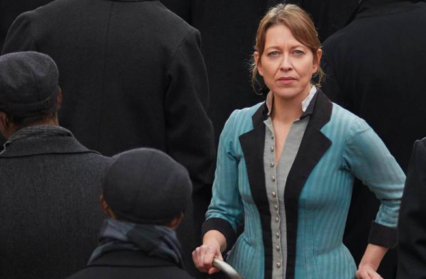David Cottis reviews The Corn Is Green, a play by Emlyn Williams, in its first London revival in 35 years.
More than two years after it was first announced, Dominic Cooke’s production of Emlyn Williams’ semi-autobiographical 1938 play, a victim of the first lockdown, has finally opened in the Lyttelton theatre, with its originally scheduled star, Nicola Walker, as the crusading teacher who encourages her working-class pupil, Morgan Evans, to choose an application to Oxford over a life in the mines. Was it worth the wait? Surprisingly enough, yes.
‘Semi-autobiographical’ is a slightly generous word – anyone who’s read Williams’ ‘early autobiography’ George will know that the play is far more sentimental and polarised than the experience it’s based on, though it is true that he was a working-class child, spotted by a teacher, Miss Cooke, and encouraged to Oxford. The play pushes the story back a few decades, locates it in a fictional, mostly Welsh-speaking, village, and simplifies the class element, so that Morgan Evans – Williams’ surrogate, and the part he wrote for himself – becomes a hard-drinking young miner rather than the bookish publican’s son that Williams actually was, and the teacher, Miss Moffat, an eccentric Englishwoman who uses her own money to finance the school, it’s an archetypal British story; education as the escape from your class and background, that looks back to Shaw’s Pygmalion, and forward to Educating Rita, Billy Eliot and (on this very stage) The History Boys.
Taking his cue from Stephen Daldry’s production of An Inspector Calls, Cooke sets the play firmly in the context of its writing, and Williams’ own life. We start with the author at a fashionable ‘30s party, slipping away and becoming surrounded by a chorus of miners from his past. They start to sing, hiraeth kicks in, and he begins to write the play, calling the characters onto a bare stage, Prospero-style. We gradually add furniture and props, so that it’s not until the second half that we get a conventional ‘thirties fourth-wall set. As a device, it starts out being a little irritating, but gradually earns its keep, throwing a light onto the playwright’s choices so that a couple of the weaker elements of the writing, such as a one-dimensional English squire, become ironised, and the focus is placed firmly on Williams’ spiky dialogue. The miners’ singing takes the place of scenery – Calon Lan in particular features effectively.
The Corn is Green is unusual in Williams’ work in that he didn’t write the best part for himself – part of the reason for the play’s endurance it that it can act as a vehicle for unconventional leading ladies like Sybil Thorndike, Katharine Hepburn and Deborah Kerr. Few actors are as good as conveying intelligence as Nicola Walker, and she approaches the part with forensic skill, playing set piece scenes, like a mock-flirtation to get the dim-witted squire onside, for all they’re worth, and making the character likeable despite the control-freakery that causes Evans (Iwan Davies, making his professional debut) to rebel just before the First Act curtain. Wisely, neither of them plays a romantic subtext; Williams, like Shaw with Pygmalion, always insisted that this was just a pupil/teacher relationship and, unlike Shaw, he’s proved right by the play – these two characters have a relationship far more precise and unusual than any lovers ever did. Strong support is provided by Saffron Coomber as Bessie Watty, the Cockney ‘dollymop’ whose pregnancy suggests a different future for Evans, and Richard Lynch as the evangelist John Goronwy Jones.
Can we have Night Must Fall next?
The Corn is Green is showing until 11 June.












